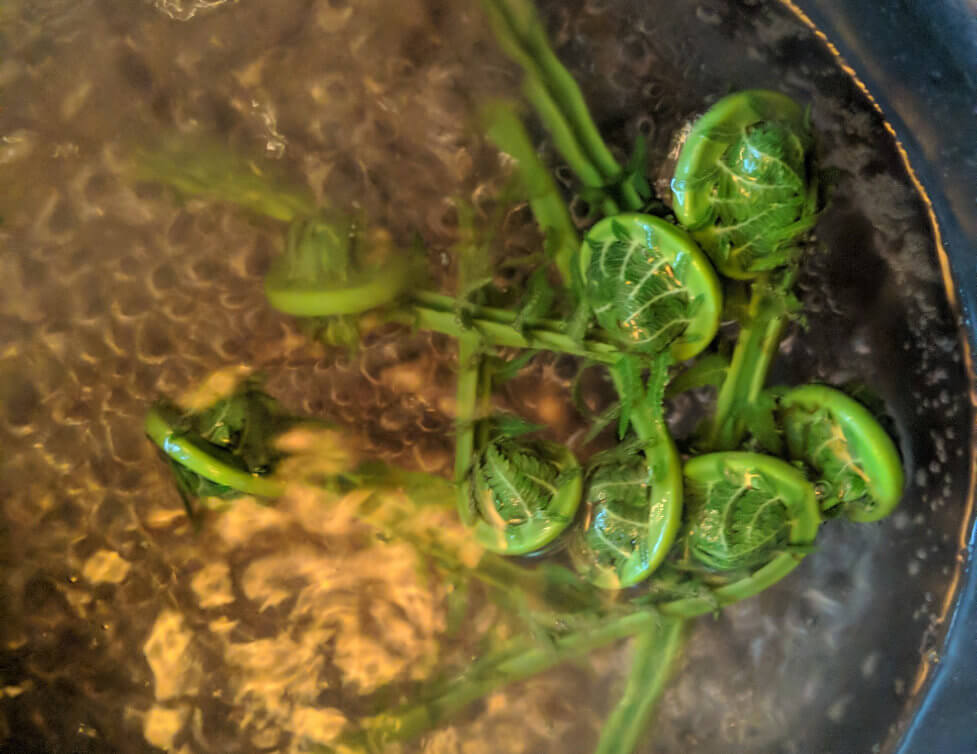Identifying, Harvesting, and Eating Fiddlehead Ferns
Until today, every day of my 33 years on earth have been spent unaware that the ferns in my parent’s backyard in Pennsylvania were a prized choice edible. Fiddlehead ferns are the most delicious thing I’ve ever foraged. They are also the first plant or mushroom I foraged where I didn’t do my homework and got extremely sick. Read on to learn how to enjoy a delicious seasonal vegetable and avoid the food poisoning.
Note: I am not an expert! I am someone that has an interest in learning more about the land and wildlife around me with an emphasis on things I can eat. There are many plants that will make you sick or might even kill you. Please take precaution when foraging wild ingredients and consult an expert before consuming any unknown plant or mushroom.
What Is A Fiddlehead?
Fiddlehead is a general term for the unfurled frond of a young fern. Fiddleheads are best when harvested young before they’ve had a chance to grow and unfurl with lots of tiny leaves up the stalks.
Fiddleheads can be harvested as a vegetable, however you want to make sure that you’re collecting them from the right type of fern.
How To Identify An Edible Fiddlehead Fern
The choice edible fiddleheads come from the Ostrich Fern. Three primary characteristics you should look for to identify an Ostrich Fern:
- Deep U-shaped groove in the smooth, green stem of the fern
- Fronds are grouped and appear to be growing out of a ‘crown’
- Brown tissue paper like covering at the base of the fern
To avoid killing the plant you do not want to remove all of the fiddleheads from the fern. Leave at least 2-3 fronds so that you’ll have a fern to return to next year.
What do fiddlehead ferns taste like?
The flavor of a fiddlehead is a cross between fresh asparagus and an artichoke heart. Some people describe them as being similar to broccoli with a shade of spinach.
Artichokes and asparagus are two of my favorite vegetables so I was blown away with how good fiddleheads were. Highly recommended.
Are Fiddlehead Fern Stalks Edible?
Yes! While normally you will see photos or packaged fiddleheads cut close to the coil, the stalks are just as delicious.
When To Harvest Fiddlehead Ferns in Pennsylvania
The best time to harvest fiddlehead ferns is in early to mid-April when the fronds are just starting to pop up out of the ground. You want to try to catch them when they’re still tightly coiled and about 1-2″ in diameter.
I started noticing fiddleheads during the last half of April which is a little late in their season. Next year I’ll be ready!
Food Poisoning From Fiddlehead Ferns
Foraging wild ingredients isn’t risk free. I learned that the hard way with fiddlehead ferns. Had I done more research before eating I would have seen that there were many articles talking about how it is not uncommon to get food poisoning 3-12 hours after eating undercooked Fiddlehead Ferns.
Eating raw or improperly cooked fiddleheads can cause symptoms of foodborne illness. The cause is likely an unidentified natural toxin in fiddleheads. Symptoms usually begin 30 minutes to 12 hours after ingestion and may include nausea, vomiting, diarrhea, abdominal cramps, and headaches.
British Columbia Drug and Poison Information Center
After a four hour ordeal that started 3 hours after eating my fiddlehead ferns, I can confirm this description to be accurate. Turns out my 2-3 minute sautée in butter was not enough.
How To Prevent Food Poisoning From Fiddlehead Ferns
After doing more reading on the subject I learned that the best way to avoid any foodbourne illness from fiddlehead ferns is to either steam or boil them for 5-10 minutes.

I boiled the second batch of ferns I harvested for 10 minutes and did not get sick afterward. Unfortunately, I found that boiling removes a lot of flavor and takes a delightful crunch and turns it into mush.
Next year I am going to try steaming them for 10 minutes and if all goes well, I want to reduce it to 5 minutes. The flavor of fiddleheads is worth the risk in my book!